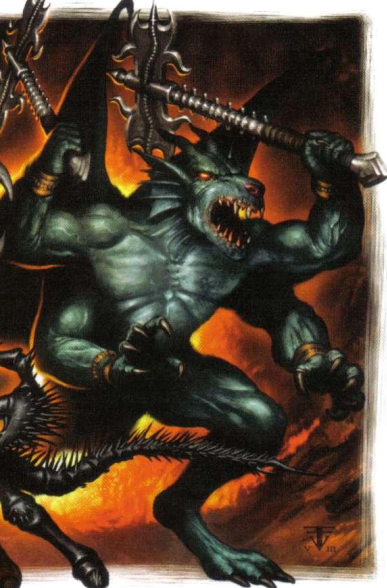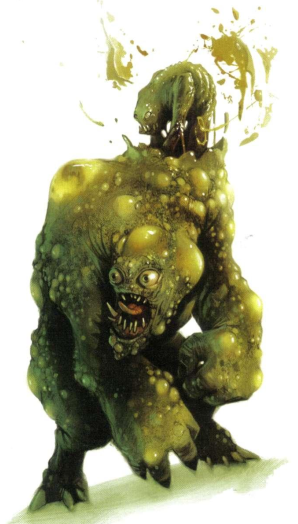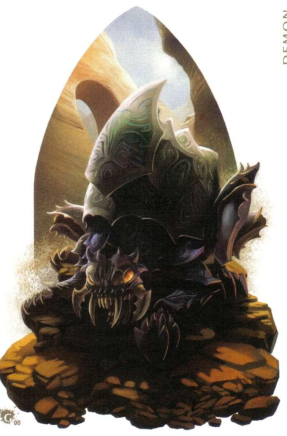Let's Read the 4e Monster Manual 2: Demons, Part 3
This is part of a series! Go here to see the other entries.
We continue looking at the many monsters in the Demons entry of the Monster Manual 2.
Nycademon

I’m pretty sure these winged, four-armed creatures used to be classified as Yugoloths in previous editions, where their name was written as “Nycadaemon”. Yugoloths, or daemons, were the Neutral Evil Fiends, created because the writers of AD&D decided every alignment needed its own representative outsider. Fourth Edition uses a different cosmology and a different alignment system, so its authors elected to turn daemons into demons.
Nycademons spend their days flying over the open expanses of the Abyss in search of creatures to snatch and drop from a great height, which they think is hella funny. This has given them the nickname of “sky demons”. They place great value in physical strength, and so have a tendency to underestimate beings whose power is less obvious (“Do you even lift, bro?”). They’re also hesitant to attack someone who seems big and strong, for the same reason.
Like many former daemons, nycademons have a mercenary temperament and will work for anyone who pays them. These contracts tend to be short-lived though, as their superiority complex tends to infuriate most allies. All that flexing can get annoying really fast.
The Numbers
Nycademons are Large Elemental Humanoids (demons) and Level 22 Skirmishers with 210 HP. They have Variable Resistance 20 (2/encounter), as well as ground and fly speeds of 6. The one in this book fights with a pair of greataxes it wields one-handed, leaving it with two free hands to snatch victims.
Its Wicked Axe attacks are Reach 2 and High-Crit, and also cause ongoing 5 damage (save ends). Wicked Edges allows it to make two such attacks in one action, putting its damage near where it should be even without the math fix.
Instead of axing someone, the nycademon can Snatch them (Reach 2 vs. Fortitude). It can fly 6 squares before or after making the attack, which does no damage but grabs the target. The Strong Flyer trait exempts it from the usual obstacles to moving a grabbed target, so it can travel its full speed with the grabbed victim without needing to make additional tests to do so.
All of these traits lend themselves well to the “snatch and drop” tactics described in the lore. Grab someone, fly up for a few rounds while attacking them with the axes, drop them for a bunch of d10s of fall damage.
The sample encounter has three nycademons, a goristro and a rot harbinger. It’s Level 21, and likely affiliated with Orcus.
Impressions
While mechanically simple, I kinda like the whole “snatch and drop” thing. It’s also fun to imagine these creatures as condescending gym bros.
Pod Demons

Particularly disgusting examples of demonkind, these slimy creatures can spawn miniatures of themselves from their blistered bodies, using them to corner and terrorize their victims.
The spawn have no mind of their own, being extensions of the demon’s main body. In fact, the pod demon can transfer its conscience to a podling, causing it to grow to full size while the original body shrinks.
These creatures have some connection to the mysterious Chained God (AKA Tharizdun, but no one in-setting rememebers that name). Some of them wrap themselves in chains to show their allegiance.
The Numbers
Pod Demons are Large Elemental Humanoids (demons), and Level 15 Elite Artillery with 176 HP. They have darkvision and Variable Resistance 15 (2/encounter). Their ground speed is 8.
They fight by using their half-formed spawn as ammo. They can either throw a spawn so it explodes on impact using Fling Podspawn (area burst 1 within 10 vs. Reflex), or squeeze it to spray nearby enemies with Spew Podspawn (close blast 3 vs. Reflex). In either case, targets take acid damage on a hit.
Fully formed podspawn constantly pop free of the parent body: one appears within 2 squares of the original at the start of its turn as long as there are fewer than 4 podspawn in play. The parent can also force them out with Generate Podspawn (close burst 2 vs. Reflex), which does poison damage and fills unoccupied squares with enough podspawn to reach the limit of 4.
As a move action the pod demon can Transfer Essence, effectively swapping positions with a podspawn within 10 squares. As a minor action it can use Detonate Minion (ranged 10), causing a podspawn in range to explode and deal a bit of automatic poison damage to adjacent creatures.
If forced into melee, they attack with a weak Claw that also does ongoing poison damage (save ends).
I’m guessing that if you have multiple pod demons in play, each of them will be able to have its own set of four minions.
The podspawn themselves also have a little stat block. They’re Level 15 Minion Skirmishers whose resistances always match the parent’s, and who attack with a corroding slime that’s slightly stronger than the parent’s claw. Their dangerous proximity trait gives them combat advantage against any adjacent enemy, no flanking required.
The sample encounter is level 16: 1 immolith, 1 pod demon, 4 podspawn and 2 red slaads.
Runespiral Demon
These turtle-beetle things have complex patterns of arcane runes etched into their shells, which channel arcane energies from deeper within the Abyss. The specimens depicted here turn this energy into lightning, but there are others with variant runic patterns that use other elements.
Runespiral demons are sapient, but they don’t have hands and are nowhere near smart enough to be good at arcane magic. The runes are either natural or etched by some unseen patron. In combat, they rely on the magic of these runes to attack at range.
The Numbers

We actually get two varieties here: common Runespiral Demons are Small Elemental Magical Beasts, and Level 5 Artillery with 51 HP. Arctide Runespiral Demons are Large, and Level 12 Artillery with 97 HP. They have Variable Resistances of 10 and 15 respectively, and a ground speed of 7. Their attacks are almost identical.
They can attack distant opponents with either a Focused Strike (ranged 10 vs. Reflex) that does standard lightning damage, or a Lightning Burst (Area Burst 2 Within 10 vs. Reflex), which does bit less lightning damage as a baseline, but has that damage increase by 1 for each creature caught in the blast. That’s creature, not enemy: allies caught in the blast will increase its damage, but will also be damaged by it since it’s not a selective burst. The Arctide Demon’s burst is also Charged: it does all of the above and additionally gives allies damaged by it a +1 bonus to their next recharge rolls.
When an enemy moves adjacent to one of these demons they release an Arcane Arc (melee 1 vs. Reflex) as an interrupt, dealing lightning damage. In melee they’ll bite for very little physical damage, and when bloodied they release a Bloodied Shock (close burst 1 vs. Reflex) that deals lightning damage and dazes.
The sample encounter has 2 basic runespiral remons, 2 evistros, and the human hexer who summoned them all.
Impressions
More demon artillery support. They have some mechanical weaknesses: all of their good attacks deal the same type of damage and target the same defense. Some GMs might want to pull a Gygax and say that runespiral demons with other elements look identical save for their different runes and that it takes an Arcana test to distinguish them.
Rupture Demon
These demonic amoeboids are the least spawn of Juiblex, and they act as abyssal scavengers, following more powerful demons around and eating the remains of their kills. When they die their own remains can infest those more powerful demons and make them even stronger. Does that serve some plan of Juiblex? No one knows.
The Numbers
Rupture Demons are Level 5 Minion Soldiers, with low-light vision, a ground speed of 6 and a climb speed of 3 with Spider Climb. They lack any elemental resistance.
They can attack directly with a Slimy Extrusion for minor physical damage, or they can use an Enveloping Embrace. This hits automatically, does no damage and restrains the target (save ends). It also kills the demon, presumably because it has to rupture to envelop someone.
When a rupture demon dies, either due to an attack or from using the Embrace, it explodes into a mass of ichor and pseudopods that latches onto another demon within 5 squares. This infestation heals 5 HP and gives it a +2 damage bonus. Multiple infestations stack, up to a maximum of +10 damage. For this to work the infested demon must be level 10 or less.
The sample encounter has 1 Black Pudding, 1 Evistro, and 6 rupture demons. An interesting contrast, because the pudding is going to split into smaller enemies and the rupture demons will join with the Evistro as the fight goes on.
Impressions
I like their concept! The level limitation is a bit strange. Presumably you could have higher level minions that could affect more powerful demons. In that case you should make sure they’re still a few levels behind the “real” opposition, since you want them to die fast and provide that damage bonus.
End of Part 3
There’s one more to go, with the last remaining demon.